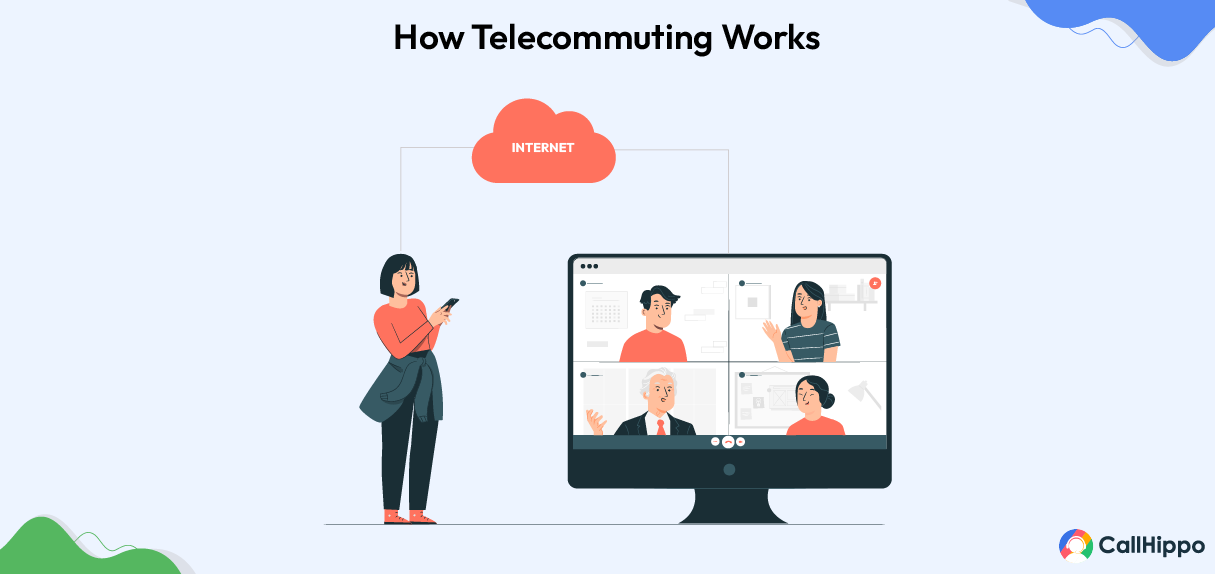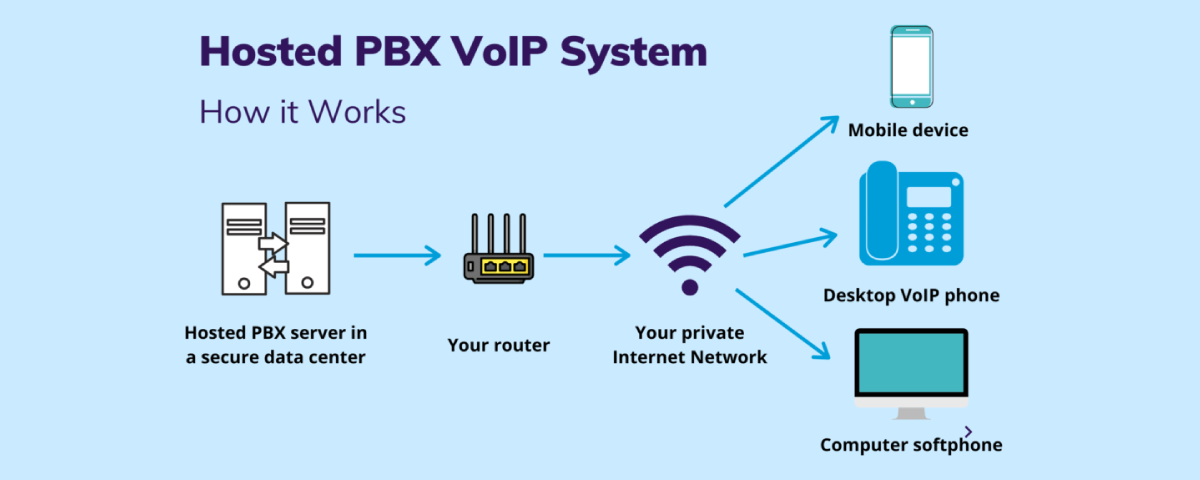“People are more productive working from home than people would have expected.” Mark Zuckerberg, CEO of Facebook.
No longer do employees go through the regular 9 – 5 grind. Flexibility is the new trend – companies want productive employees whether they work from home, in a coffee shop, or a coworking space.
The potential for remote work is tremendous. Did you know that 55% of global businesses offer some capacity for telecommuting?
Undoubtedly, the scope of telecommuting is increasing day by day. Adopting work-from-home policies has saved US employers over $30 billion a day during office closures during the Coronavirus pandemic.
So are you thinking about switching to remote working and understanding telecommuting technology? Read on to know how this trend can impact your workplace and bring positive results!
What is Telecommuting?
A recent concept, telecommuting, is a work arrangement that does not require an employee to commute to the traditional workplace. It empowers employees to deliver work assignments remotely, and companies use Internet-based technology to share information and communicate with each other.
Telecommuting technology enables employees to work outside the traditional brick-and-mortar organization. There is no requirement to invest in office space, and it leads to significantly lower operating costs.

The best part is that productivity does not suffer, as 77% of telecommuters report being more productive. A win-win situation for both the organization and employee, indeed!
How Telecommuting Works?
Telecommuting is smart and flexible as it enables modern organizations to collaborate on work assignments without any employees being physically present. It is the new ‘normal’ – we can be certain that remote work is here to stay!
With the advent of technology, many sophisticated tools make it easier for companies to implement telecommuting and accrue its maximum benefits. Let’s check out how telecommuting technology works in the current scenario:

1. Mobile Workspace
With Wi-fi omnipresent nowadays, it becomes easy for organizations to create a mobile workspace. Since 59% of professionals use at least three devices at work, they can easily connect to a wi-fi connection and work on business projects from any corner of the world.
With the culture of mobile workplaces, employees can pace work at their speed and work from home or any geographical location. Many telecommuters also invest in taking a cubicle in coworking spaces as they get access to a work desk, computers, and meeting rooms.
2. Virtual Project Management Platforms
With virtual project management platforms, managers can keep deliverables on track and increase team collaboration.
Project management software is the latest trend in the business ecosystem. Since project management tools save the average employee 498 hours every year, it is a good investment for virtual teams.
There are multiple cloud-based project management software that remote teams can use to enhance business communication and boost productivity of your employees. Some popular examples include Trello, Asana, and Basecamp. These cloud-based platforms ensure that all team members have access to documents, files, and project resources anytime, anywhere.
3. Multiple Communication Channels
A virtual work environment makes it necessary for companies to invest in multiple communication channels to check in with each other and keep connected. Not only is this more cost-effective than business travel, but virtual communication platforms also lead to tremendous efficiency.
There are a host of diversified tools such as CallHippo’s business phone systems that allow remote team members to communicate and make and receive economic calls and also brainstorm through face-to-face video conferencing. Applications such as Slack, Monday.com, and Bitrix24 enable virtual employees to create channels for work projects and share information seamlessly without any delays or encumbrances.
7 Essential Telecommuting Tools for a Smooth Remote Work Transition
The following are some of the tools and software you will need to make telecommuting a success. These tools will assist you in streamlining, automating, and seamlessly performing all of your tasks. Besides, the list includes a wide range of software and utility software, from project management tools to communication tools to VoIP systems.

Let’s take a quick look at each of them.
1. High-Speed Internet Connection
Yes, we very well know that high-speed internet is not a telecommuting technology, but it is a critical technical requirement that you will certainly need for performing remote work efficiently. With a slower internet connection, you will be unable to complete the work on time.
So, in addition to using reliable devices such as a router or modem, make sure you subscribe to a decent internet plan to avoid frequent disruptions in service. Also, check your internet speed regularly and notify your service provider if it falls short of what was promised.
2. VoIP Phone System
If you want to ensure that your customer service operations run smoothly even when telecommuting and that your customer representatives provide the best possible support to your customers, then buy VoIP phone systems right away! VoIP is a cloud-based phone system that operates over the internet. It encompasses a range of features such as an auto-attendant, call routing, and call forwarding, call barging, call recording, call monitoring and analytics, and so on.

( Source: 360connect )
All of these VoIP features, when combined, will develop a solid communication system that will help you in streamlining and automating customer care operations even while working remotely, ensuring the highest level of customer satisfaction.
Recommended VoIP Phone System: CallHippo
3. Collaboration Tools
Reduced productivity is often associated with poor team collaboration. However, when it comes to telecommuting, the risk of communication breakdown or miscommunication increases significantly. That is why you require a type of telecommuting technology known as collaboration tools.
These tools are specially designed to assist remote teams in working on multiple projects at the same time. In addition, most collaboration platforms also include a slew of other features such as file sharing, progress dashboards, reports and analytics, and so on.
Recommended Collaboration Tools: Slack, Huddle, Zapier
4. Project Management Software
To ensure that your project is completed on time, even when telecommuting, you should invest in reliable project management software. When switching to the remote working model, free project management software is an essential telecommuting technology that should not be overlooked.

( Source: kissflow )
Project management software will assist remote teams in organizing, tracking, and managing work efficiently. You can use this tool to determine the project’s workflow as well as a timeline to ensure that it is completed on time without fail.
Recommended Project Management Software: Asana, Trello, ProofHub
5. Productivity Tools
We all are human beings and not machines, right? This means, unlike machines, we tend to forget things and make mistakes. Although we cannot prevent all errors, we can certainly limit them by implementing productivity tools. Productivity tools comprise a variety of different tools such as time-tracking tools, note-keeping tools, project monitoring tools, and so on.
These tools serve as utility tools for the primary software, ultimately improving overall productivity and performance when telecommuting.
Recommended Productivity Tools: Keka, EverNote, HubStaff, ToDoist
6. Communication Tools
Communication is indeed the key when it comes to telecommuting. To ensure that communication between teams stays smooth and seamless, you’ll need at least 2-3 good communication channels. Furthermore, this telecommuting technology is critical since its absence can harm the overall productivity and performance of the project as well as your other business operations.

( Source: covrisolutions.wordpress )
For these reasons, when you pick a remote working model, you must first ensure that you have the best communication tools in your arsenal.
Recommended Communication Tools: CallHippo, GSuite, Google Meet, Loom
7. Security Tools
When you do most of your job over the internet by internet communication and via communication technologies, the risk of a cyber-attack or data breach increases considerably. For these reasons, you will undoubtedly require a commuting technology known as security tools, to safeguard your data.
The security tools will provide you with the appropriate security cover for your entire system and protect critical data from malicious attacks. In addition, when you have these technologies in place, you can easily share data and files with your teams over both the networks – intranet or internet.
Recommended Security Tools: TeamViewer, Okta, 1Password, Amazon Web Service (AWS).
These are the 7 telecommuting technologies that businesses must invest in and implement if they choose full-time remote working. Not only will these telecommuting tools expedite and automate operations, but they will also safeguard your data from malicious cyber threats.
So the question now is, what does the future hold for telecommuting? Is it here to stay, or will it fade away after a few years?
Benefits Of Telecommuting for Employees
Did you know that a whopping 99% of remote workers revealed in a recent survey that they would wish to continue with this mode of work in the future?
This proves that telecommuting is working well for modern businesses. Here are some reasons you should consider adopting remote work arrangements for your organization:
1. Save Money
With office work desks remaining vacant for 50-60% of the time, telecommuting is a great option for organizations to help them save on maintaining a physical work infrastructure.
With remote working arrangements, organizations can downsize their office space to a minimum and reduce office supplies and equipment. It can bring down routine operational expenses and lead to a significant increase in overall business revenues.
2. Boost Employee Productivity
One of the biggest myths about telecommuting is that it leads to a dip in productivity. Recent research shows that 85% of businesses reported higher employee output after making the switch to telework.
Telecommuting allows employees to set up a personalized work environment to perform according to their schedule and deliver better results. The best part about remote work is that it eliminates the time taken to commute to the workplace; hence employees can utilize that time gainfully.
3. Help Capture The Best Global Talent
When organizations function from physical work environments, they need to hire the best talent from a specific geographical region or hire people willing to relocate. However, with virtual job opportunities, companies remove this constraint and can attract the best global talent to apply for vacant positions.
Remote jobs are a norm in most countries now. 80% of the US workforce would turn down a job offer if it does not have flexible work options. Telecommuters also report higher job satisfaction than average employees; hence organizations can expect a jump in retention by providing flexible job arrangements.
Closing Thoughts
If you are looking to surge ahead of industry rivals, make sure to leverage the power of remote work. With 73% of all teams having remote workers in the next decade, we can expect a paradigm shift towards telecommuting shortly.
Employees are displaying strong preferences for flexible job arrangements. The rise in cloud-based technological platforms makes it easy for this to work out in the long run.
Create a virtual work environment and offer your workforce telecommuting options to enjoy better operational efficiency now. Let us know how telecommuting worked for you – share your thoughts in the comments section below.

Subscribe to our newsletter & never miss our latest news and promotions.









